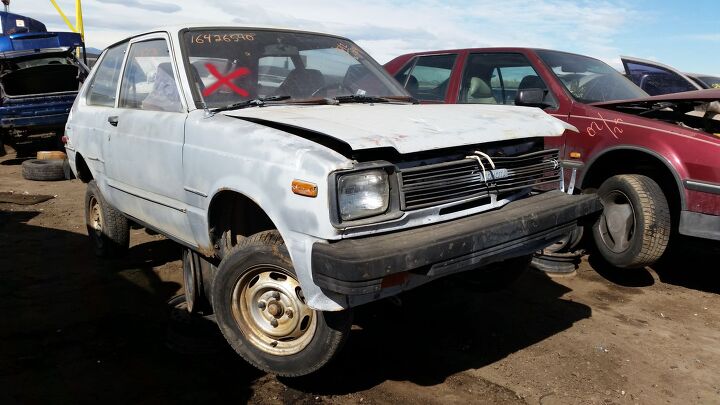Junkyard Find: 1982 Toyota Starlet

The Toyota Starlet was sold in the United States for the 1981 through 1984 model years, though not in large numbers. It was rock-and-stick simple, had rear-wheel drive and an unkillable pushrod engine, and it got a (claimed) 54 highway mpg. But it was tiny and cramped even by Miserable Econobox standards and had to compete with the Corolla Tercel on the very same showroom floors. Since the Tercel was cheaper, roomier, more powerful (everything is relative!), and generally more modern, American Starlets were rare to start with. They have become even more rare today, as generations of wild-eyed engine-swappers tripled Starlet horsepower and stuffed the handful of remaining examples (that didn’t succumb to rust) into concrete abutments and dragstrip K-barriers.
Here’s a Colorado ’82 that is as close to being completely used up as any vehicle I have ever seen in a wrecking yard.
It’s apparent that this car’s final owner didn’t believe in squandering money. When the rear glass broke (probably in one of the many punishing hailstorms we get here on the High Plains), a rectangular piece of Lexan was fitted into the trapezoidal hatch opening with wood framing, scrap metal, tape, and plenty of screws.
This bit of get-it-done-today-for-$1.99 fabrication ranks right up there with drilling hundreds of vent holes in your Tercel’s plastic replacement side glass, securing your Cadillac’s doors with riveted-on padlock hasps, and the emergency Accord trailer hitch in the annals of automotive field expedient engineering.
The 4K-C engine in the Starlet made an incredibly dependable 58 horsepower, come snow, rain, heat, or gloom of night. Since the Starlet’s curb weight was just 1,724 pounds (versus the relatively elephantine ’82 Tercel hatchback’s 1,915 pounds), it wasn’t anywhere near as sluggish as the horsepower figures might suggest. Think about that next time you read some car reviewer trashing the Mitsubishi Mirage for hauling its 2,029 pounds with “only” 74 horses.
I wasn’t able to figure out the reasoning behind this strange repair, which seems to be a flour-and-water-paste-soaked kitchen towel taped over the mangled fender. Perhaps it was supposed to reduce the danger to pedestrians posed by sharp metal edges?
When I first laid eyes on this car, I guessed that I would see at least 400,000 miles on the clock. Nope, just 224,572. The extensive sun-bleaching suggests that it sat outdoors for a couple of decades prior to washing up at my local U-Pull-and-Pay, so it may have been on pace to reach some outlandishly high mileage figure before it got abandoned. Note the corrections for 55 and 65 miles per hour on the speedometer, suggesting that larger-than-stock tires may have reduced the indicated speed.
There’s some rust in the usual Malaise Era Toyota spots, though nothing very serious. Worth restoring? No way. Sad to see the death of a Starlet? Definitely.
More miles per gallon than any other car!
In the Starlet’s homeland, fuel economy was pitched with much greater levels of excitement.
You could get reasonably sporty ’82 Starlets in Japan, too.
We never saw U.S.-market Starlet ads showing EFI-equipped cars snarling around mountain switchbacks. Happy Choice!
OK, so this JDM ad is from a decade later, but it deserves viewing for its amazing levels of tachycardiac frenzy.
One of the main reasons you don’t see too many Starlets on the street today is that so many of them have ended up doing stuff like this.
There’s a 4AGE-swapped Starlet racing in West Coast 24 Hours of LeMons events, and it’s fairly quick. Not as quick as an FX16 Corolla GT-S with the same engine, maybe, but it has more character.

Murilee Martin is the pen name of Phil Greden, a writer who has lived in Minnesota, California, Georgia and (now) Colorado. He has toiled at copywriting, technical writing, junkmail writing, fiction writing and now automotive writing. He has owned many terrible vehicles and some good ones. He spends a great deal of time in self-service junkyards. These days, he writes for publications including Autoweek, Autoblog, Hagerty, The Truth About Cars and Capital One.
More by Murilee Martin
Latest Car Reviews
Read moreLatest Product Reviews
Read moreRecent Comments
- Dave Holzman My '08 Civic (stick, 159k on the clock) is my favorite car that I've ever owned. If I had to choose between the current Civic and Corolla, I'd test drive 'em (with stick), and see how they felt. But I'd be approaching this choice partial to the Civic. I would not want any sort of automatic transmission, or the turbo engine.
- Merc190 I would say Civic Si all the way if it still revved to 8300 rpm with no turbo. But nowadays I would pick the Corolla because I think they have a more clear idea on their respective models identity and mission. I also believe Toyota has a higher standard for quality.
- Dave Holzman I think we're mixing up a few things here. I won't swear to it, but I'd be damned surprised if they were putting fire retardant in the seats of any cars from the '50s, or even the '60s. I can't quite conjure up the new car smell of the '57 Chevy my parents bought on October 17th of that year... but I could do so--vividly--until the last five years or so. I loved that scent, and when I smelled it, I could see the snow on Hollis Street in Cambridge Mass, as one or the other parent got ready to drive me to nursery school, and I could remember staring up at the sky on Christmas Eve, 1957, wondering if I might see Santa Claus flying overhead in his sleigh. No, I don't think the fire retardant on the foam in the seats of 21st (and maybe late 20th) century cars has anything to do with new car smell. (That doesn't mean new car small lacked toxicity--it probably had some.)
- ToolGuy Is this a website or a podcast with homework? You want me to answer the QOTD before I listen to the podcast? Last time I worked on one of our vehicles (2010 RAV4 2.5L L4) was this past week -- replaced the right front passenger window regulator (only problem turned out to be two loose screws, but went ahead and installed the new part), replaced a bulb in the dash, finally ordered new upper dash finishers (non-OEM) because I cracked one of them ~2 years ago.Looked at the mileage (157K) and scratched my head and proactively ordered plugs, coils, PCV valve, air filter and a spare oil filter, plus a new oil filter housing (for the weirdo cartridge-type filter). Those might go in tomorrow. Is this interesting to you? It ain't that interesting to me. 😉The more intriguing part to me, is I have noticed some 'blowby' (but is it) when the oil filler cap is removed which I don't think was there before. But of course I'm old and forgetful. Is it worth doing a compression test? Leakdown test? Perhaps if a guy were already replacing the plugs...
- Crown No surprise there. The toxic chemical stew of outgassing.





















































Comments
Join the conversation
When I think think of sub 1800 lb cars with indestructible pushrod motors, '77-'80 Fiesta. It had 66 hp, more room, and better looks than this little sad sack. Yes the Starlet had RWD, but very poor packaging. The Tercel on the other hand was neat little car.
Oh man, I loved the Starlet. Also, check out the photobombing of the last picture by Tim Odell's Los Huevos Ranchero, which has since met its demise. But, another one is in the works.